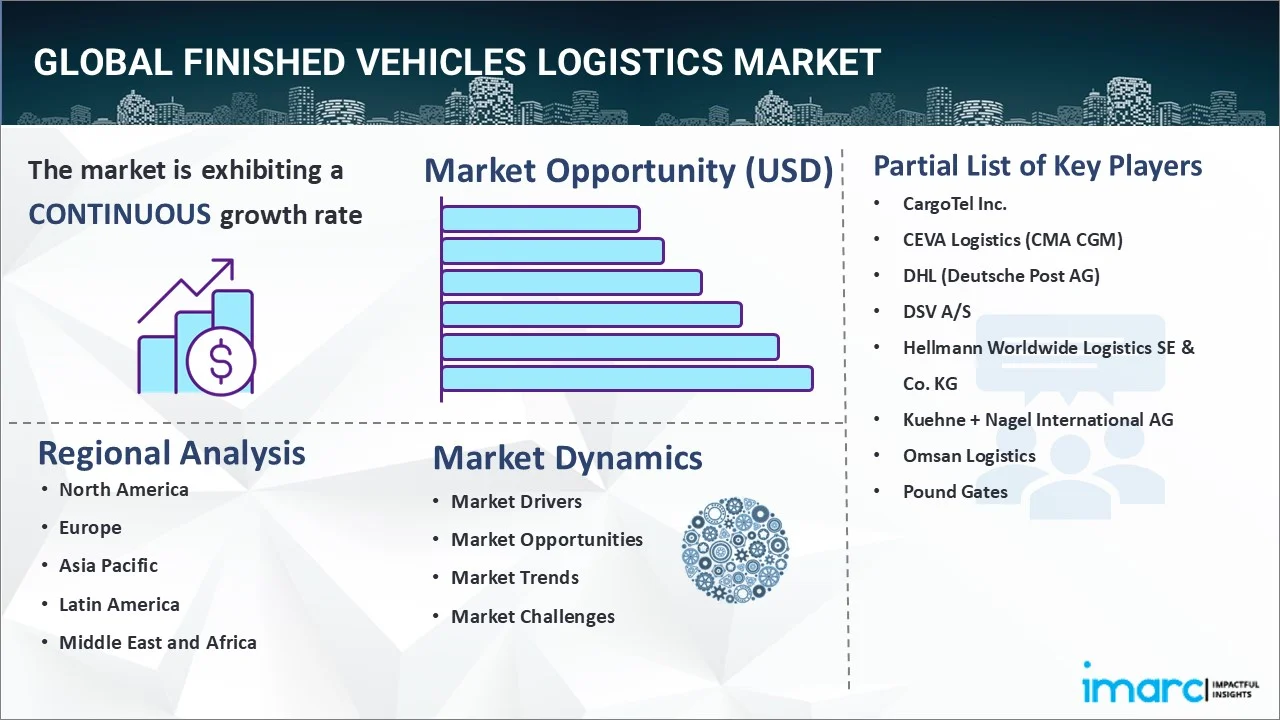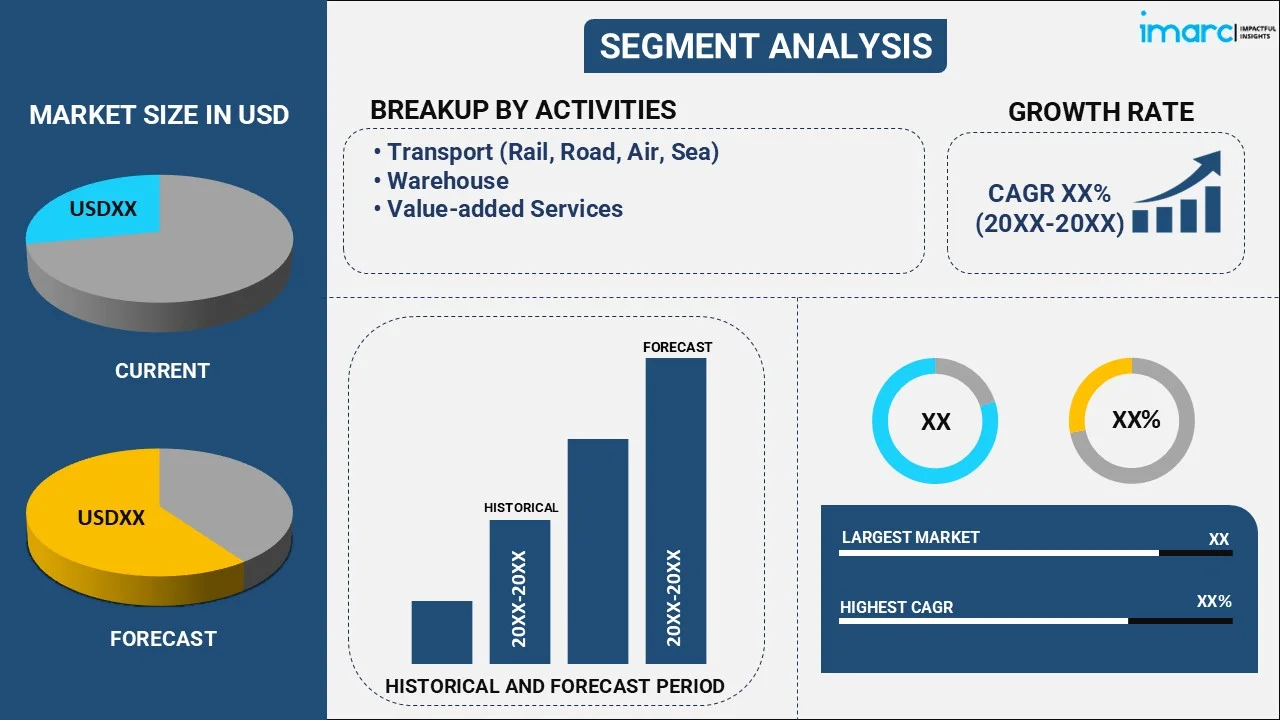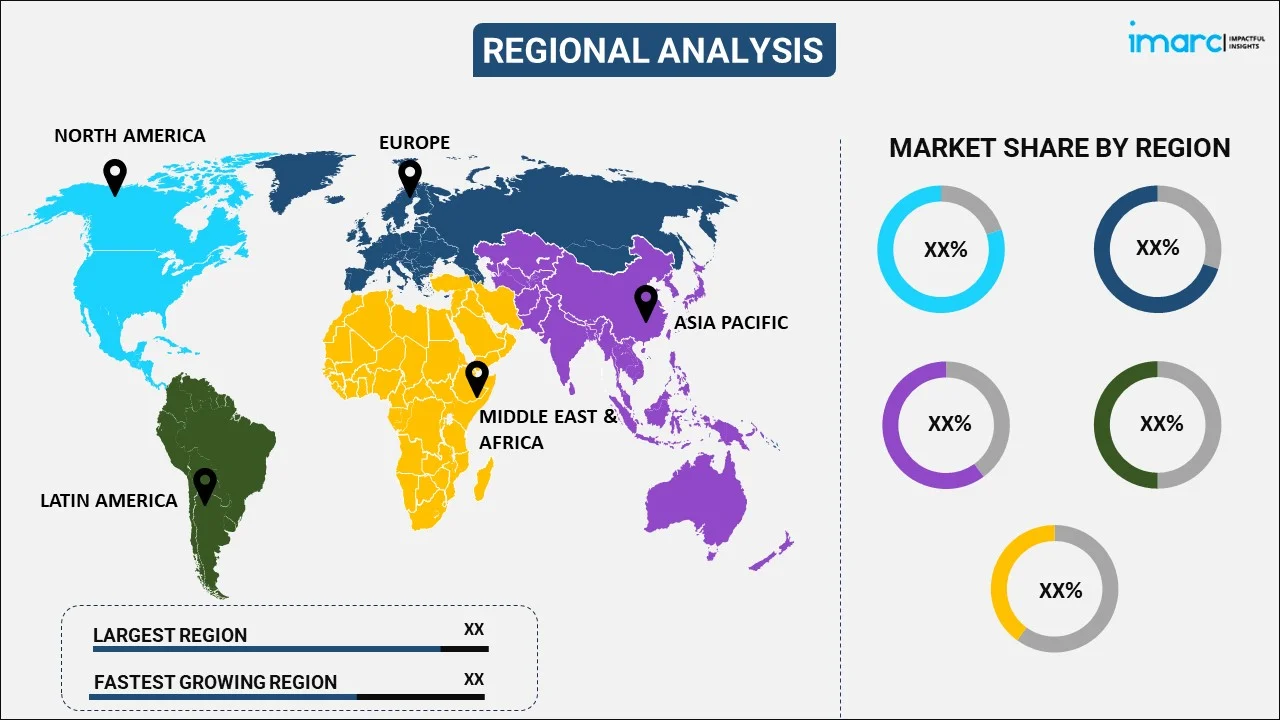
Finished Vehicles Logistics Market Report by Activity (Transport (Rail, Road, Air, Sea), Warehouse, Value-added Services), Vehicle Type (Passenger Vehicle, Commercial Vehicle, Hybrid Electric Vehicle, Battery Electric Vehicle), Distribution Channel (OEMS (Original Equipment Manufacturers), Aftermarket), and Region 2025-2033
Finished Vehicles Logistics Market Size:
The global finished vehicles logistics market size reached USD 150.1 Billion in 2024. Looking forward, IMARC Group expects the market to reach USD 218.8 Billion by 2033, exhibiting a growth rate (CAGR) of 4.26% during 2025-2033. The rising global demand for efficient vehicle distribution and growing awareness of carbon footprint reduction are driving finished vehicles logistics market growth. Stringent regulations on carbon emissions and rising adoption of electric vehicles (EVs) further propel the market growth by enhancing logistics solutions’ sustainability and efficiency.
|
Report Attribute
|
Key Statistics
|
|---|---|
|
Base Year
|
2024
|
|
Forecast Years
|
2025-2033
|
|
Historical Years
|
2019-2024
|
| Market Size in 2024 | USD 150.1 Billion |
| Market Forecast in 2033 | USD 218.8 Billion |
| Market Growth Rate 2025-2033 | 4.26% |
Finished Vehicles Logistics Market Analysis:
- Major Market Drivers: The global finished vehicles logistics market is primarily driven by the increasing global demand for new vehicles mainly electric vehicles (EVs) which necessitates efficient distribution networks. In line with this, the technological advancements for tracking and managing logistics operations further enhances finished vehicles logistics market growth. Strict environmental regulations are pushing companies to reduce their carbon footprint in transportation which in turn is compelling companies to adopt greener logistic solutions. Furthermore, the gradual expansion of automotive market in emerging economies contribute to the increasing demand for sophisticated vehicle logistics services which ensures timely and cost-effective delivery, hence driving finished vehicles logistics market growth.
- Key Market Trends: Key trends in the finished vehicles logistics market include the integration of advanced technologies such as GPS tracking, Internet of Things and blockchain for more improved transparency and efficiency in transportation processes. There is also a notable shift towards adopting more sustainable practices with an emphasis on reducing carbon footprint through optimized route planning and use of alternative fuel vehicles. In line with this, the rising adoption of electric vehicles is prompting logistics providers to adapt their operations to handle specific EV requirements, for example battery handling and charging infrastructure. The market is also witnessing an increase in the use of automation and robotics to enhance loading and unloading processes, further streamlining operations and reducing turnaround times which in turn is propelling the finished vehicles logistics market.
- Geographical Trends: Geographical trends in finished vehicles logistics market show the significant growth in emerging markets such as Asia Pacific mainly driven by increase in automotive production sales in countries like China and India. This region benefits from increase in consumer income levels and urbanization, fueling the demand for vehicles and by extension vehicle logistics. In Europe and North America, strict environmental regulations and gradual shift toward electric vehicles are pushing logistics companies to innovate and adapt green logistics solutions. Latin America and the Middle East are also experiencing significant growth driven by infrastructural developments and economic diversification efforts further enhancing their capabilities in automotive logistics.
- Competitive Landscape: Some of the major market players in the finished vehicles logistics industry include CargoTel Inc., CEVA Logistics (CMA CGM), DHL (Deutsche Post AG), DSV A/S, Hellmann Worldwide Logistics SE & Co. KG, Kuehne + Nagel International AG, Omsan Logistics, Pound Gates, among many others.
- Challenges and Opportunities: The finished vehicles logistics market faces various challenges such as fluctuation in fuel prices, regulatory changes and the rising need for adapting logistics networks to handle electronic vehicles with specific requirements like battery management. In line with this, geopolitical tensions and trade disruptions can impact global supply chains, further complicating logistics operations. However, these challenges also present opportunities for innovation and growth. The rising adoption of technology such as telematics and automated systems offers significant potential to enhance efficiency and reduce costs. Moreover, the global push towards sustainability opens avenues for integrating green logistics practices, like using electric or hybrid delivery fleets positioning companies as leaders in environmentally responsible logistics solutions.

Finished Vehicles Logistics Market Trends:
Increase in Sustainability Initiatives
Sustainability initiatives and the finished vehicles logistics market are gaining momentum as companies nowadays are increasingly focused on reducing their carbon footprint. For instance, in 2022, Hellmann Worldwide Logistics launched a new weekly train service between Bremen and Chongqing on the Silk Road in order to meet the growing demand for Europe- Asia rail connections. This initiative aims to provide a sustainable and efficient alternative for transporting cargo between two regions. In line with this, there is a gradual shift toward the use of alternative fuel vehicles such as those powered by electricity, hydrogen or biodiesel which can significantly reduce pollutants as compared to traditional diesel engines.
Increase in Technological Innovations
In the Finished Vehicles Logistics market, technological integration plays a pivotal role. The widespread adoption of GPS ensures precise vehicle tracking throughout transit, enhancing route optimization and delivery timelines. IoT technology facilitates real-time data collection on vehicle conditions and transit environments, improving operational decision-making. CEVA Logistics, a subsidiary of CMA CGM Group, is integrating Ingram Micro CLS to enhance its eCommerce and omni-channel fulfillment capabilities. This integration will strengthen CEVA Logistics' position in contract logistics and eCommerce, making it the fourth-largest global provider of contract logistics services. Additionally, blockchain technology is leveraged for its ability to create transparent and secure records of transactions and movements, greatly enhancing trust and efficiency within the logistics chain.
Increase in Digital Transformation
Digital transformation in the Finished Vehicles Logistics Market is revolutionizing how companies engage with customers and manage operations. DHL Group is investing over €2bn in digital transformation projects from 2021 to 2025, with a focus on improving customer and employee experience and increasing operational excellence. By leveraging digital tools, companies can offer enhanced customer engagement through accessible online platforms and mobile apps, enabling customers to easily track shipments, modify delivery schedules, and communicate directly with service providers. Real-time tracking technologies provide up-to-the-minute updates on vehicle location and status, greatly reducing uncertainty and improving logistics planning. Furthermore, advanced data analytics and management systems allow for more efficient route planning and resource allocation, optimizing operations and reducing costs.
Finished Vehicles Logistics Market Segmentation:
IMARC Group provides an analysis of the key trends in each segment of the market, along with forecasts at the global, regional, and country levels for 2025-2033. Our report has categorized the market based on activity, vehicle type, and distribution channel.
Breakup by Activity:

- Transport (Rail, Road, Air, Sea)
- Warehouse
- Value-added Services
Transport accounts for the majority of the finished vehicles logistics market share
The report has provided a detailed breakup and analysis of the market based on the activity. This includes transport (rail, road, air, sea), warehouse and value-added services. According to the report, transport (rail, road, air, sea) represented the largest segment.
Transportation, encompassing rail, road, air, and sea, represents the backbone of the Finished Vehicles Logistics Market, accounting for the majority of its market share. Road transport, due to its flexibility and reach, is particularly pivotal in delivering vehicles directly to dealerships or end consumers. In 2022, more than three-quarters (78.6 %) of EU road freight transport in tonne-kilometers was carried by heavy goods vehicles with a maximum permissible laden weight of over 30 tonnes. Rail offers cost-effective solutions for long-distance hauls, especially across large countries or between regions. Sea transport is crucial for intercontinental shipments, whereas air freight, though less common due to higher costs, is used for the rapid delivery of high-value vehicles.
Breakup by Vehicle Type:
- Passenger Vehicle
- Commercial Vehicle
- Hybrid Electric Vehicle
- Battery Electric Vehicle
Commercial Vehicle holds the largest share of the industry
A detailed breakup and analysis of the market based on the vehicle type have also been provided in the report. This includes Passenger Vehicle, Commercial Vehicle, Hybrid Electric Vehicle, and Battery Electric Vehicle. According to the report, commercial vehicle accounted for the finished vehicles logistics market share.
The finished vehicles logistics market is dominated by commercial vehicles due to the rising demand for transportation and delivery services worldwide. E-commerce and construction activities are driving this demand, which, in turn, necessitates robust fleets of trucks, vans, and other commercial transport solutions. The growth of logistics and supply chain networks further propels this segment, while technological advancements and the development of fuel-efficient and eco-friendly commercial vehicles encourage fleet renewals and expansions. As a result, logistics services tailored to commercial vehicles are in constant demand, solidifying their dominant position in the market.
Breakup by Distribution Channel:
- OEMs (Original Equipment Manufacturers)
- Aftermarket
OEMs (Original Equipment Manufacturers) represents the leading market segment
The report has provided a detailed breakup and analysis of the market based on the distribution channel. This includes OEMs (Original Equipment Manufacturers), and Aftermarket. According to the report, OEMs (Original Equipment Manufacturers) represented the largest segment.
Original Equipment Manufacturers (OEMs) represent the leading market segment in the finished vehicles logistics market, playing a pivotal role as the primary source of demand for logistics services. OEMs are crucial because they manage the output of new vehicles that require transportation from manufacturing sites to dealerships and customers globally. The collaboration between OEMs and logistics providers is essential to ensure efficient distribution channels that maintain vehicle quality and timely delivery. OEMs often work closely with logistics companies to develop customized solutions that address specific logistical challenges, such as route optimization, inventory management, and adapting to regional regulatory requirements. This partnership is vital for maintaining the seamless flow of newly manufactured vehicles into the market.
Breakup by Region:

- North America
- United States
- Canada
- Europe
- Germany
- France
- United Kingdom
- Italy
- Spain
- Others
- Asia Pacific
- China
- Japan
- India
- South Korea
- Australia
- Indonesia
- Others
- Latin America
- Brazil
- Mexico
- Others
- Middle East and Africa
Asia-Pacific leads the market, accounting for the largest finished vehicles logistics market share
The report has also provided a comprehensive analysis of all the major regional markets, which include North America (the United States and Canada); Europe (Germany, France, the United Kingdom, Italy, Spain, and others); Asia Pacific (China, Japan, India, South Korea, Australia, Indonesia, and others); Latin America (Brazil, Mexico, and others); and the Middle East and Africa. According to the report, Asia-pacific represents the largest regional market for finished vehicles logistics.
Asia-Pacific holds the dominant position in the finished vehicles logistics market, primarily due to the rapid expansion of automotive manufacturing and sales in the region. Countries like China, India, and Japan are significant contributors, driven by their large population bases, increasing middle-class incomes, and growing preferences for vehicle ownership. In line with this, governmental initiatives promoting automotive sector growth and improvements in regional infrastructure, such as ports and road networks, further bolster the market. For instance, The Government of India (GoI) has provided subsidies amounting to 5,228 INR crore for the sale of 11,53,079 electric vehicles under the FAME India Phase II scheme as of December 1, 2023. This leadership in the market showcases Asia-Pacific’s critical role in shaping global automotive distribution trends.
Competitive Landscape:
- The market research report has also provided a comprehensive analysis of the competitive landscape in the market. Detailed profiles of all major companies have also been provided. Some of the major market players in the finished vehicles logistics industry include CargoTel Inc., CEVA Logistics (CMA CGM), DHL (Deutsche Post AG), DSV A/S, Hellmann Worldwide Logistics SE & Co. KG, Kuehne + Nagel International AG, Omsan Logistics, Pound Gates, among many others.
(Kindly note that this only represents a partial list of companies, and the complete list has been provided in the report.)
- Key players in the Finished Vehicles Logistics Market are diversifying their service portfolios to address the evolving needs of the automotive industry, including tailored solutions for electric vehicle logistics and enhanced vehicle tracking capabilities. For instance, logistics company Hellmann partnered with Capgemini to drive innovation through a workshop in their Applied Innovation Exchange. The workshop focused on exploring new technologies and solutions to help Hellmann stay competitive and meet the evolving needs of their clients. Companies are distinguishing themselves by offering value-added services such as pre-delivery inspections, vehicle customization, and real-time delivery updates. Additionally, the integration of digital tools is revolutionizing customer interactions, enabling seamless access to shipment tracking, scheduling, and management, thereby improving overall service delivery and customer satisfaction in this competitive sector.
Finished Vehicles Logistics Market News:
- In 2024, The Bolloré Group and the CMA CGM Group announced the completion of the sale of 100% of Bolloré Logistics to CMA CGM for 4.850 billion euros. This acquisition is CMA CGM's largest since its creation in 1978 and a major step in the group's logistics development strategy.
- In 2023, Hellmann Worldwide Logistics has opened its first Irish branch at Dublin Airport, offering airfreight, sea-freight, overland transportation, and customs clearance services. The move is part of Hellmann's growth strategy and follows the establishment of additional national companies in Switzerland, Slovakia, and Italy.
Finished Vehicles Logistics Market Report Scope:
| Report Features | Details |
|---|---|
| Base Year of the Analysis | 2024 |
| Historical Period | 2019-2024 |
| Forecast Period | 2025-2033 |
| Units | Billion USD |
| Scope of the Report | Exploration of Historical Trends and Market Outlook, Industry Catalysts and Challenges, Segment-Wise Historical and Future Market Assessment:
|
| Activities Covered | Transport (Rail, Road, Air, Sea), Warehouse, Value-added Services |
| Vehicle Types Covered | Passenger Vehicle, Commercial Vehicle, Hybrid Electric Vehicle, Battery Electric Vehicle |
| Distribution Channels Covered | OEMS (Original Equipment Manufacturers), Aftermarket |
| Regions Covered | North America, Europe, Asia Pacific, Latin America, Middle East and Africa |
| Countries Covered | United States, Canada, Germany, France, United Kingdom, Italy, Spain, China, Japan, India, South Korea, Australia, Indonesia, Brazil, Mexico |
| Companies Covered | CargoTel Inc., CEVA Logistics (CMA CGM), DHL (Deutsche Post AG), DSV A/S, Hellmann Worldwide Logistics SE & Co. KG, Kuehne + Nagel International AG, Omsan Logistics, Pound Gates, etc. |
| Customization Scope | 10% Free Customization |
| Post-Sale Analyst Support | 10-12 Weeks |
| Delivery Format | PDF and Excel through Email (We can also provide the editable version of the report in PPT/Word format on special request) |
Key Questions Answered in This Report:
- How has the global finished vehicles logistics market performed so far, and how will it perform in the coming years?
- What are the drivers, restraints, and opportunities in the global finished vehicles logistics market?
- What is the impact of each driver, restraint, and opportunity on the global finished vehicles logistics market?
- What are the key regional markets?
- Which countries represent the most attractive finished vehicles logistics market?
- What is the breakup of the market based on the activity?
- Which is the most attractive activity in the finished vehicles logistics market?
- What is the breakup of the market based on the vehicle type?
- Which is the most attractive vehicle type in the finished vehicles logistics market?
- What is the breakup of the market based on the distribution channel?
- Which is the most attractive distribution channel in the finished vehicles logistics market?
- What is the breakup of the market based on the region?
- Which is the most attractive region in the finished vehicles logistics market?
- What is the competitive structure of the market?
- Who are the key players/companies in the global finished vehicles logistics market?
Key Benefits for Stakeholders:
- IMARC’s industry report offers a comprehensive quantitative analysis of various market segments, historical and current market trends, market forecasts, and dynamics of the finished vehicles logistics market from 2019-2033.
- The research report provides the latest information on the market drivers, challenges, and opportunities in the global finished vehicles logistics market.
- The study maps the leading, as well as the fastest-growing, regional markets. It further enables stakeholders to identify the key country-level markets within each region.
- Porter's five forces analysis assist stakeholders in assessing the impact of new entrants, competitive rivalry, supplier power, buyer power, and the threat of substitution. It helps stakeholders to analyze the level of competition within the finished vehicles logistics industry and its attractiveness.
- Competitive landscape allows stakeholders to understand their competitive environment and provides an insight into the current positions of key players in the market.
Need more help?
- Speak to our experienced analysts for insights on the current market scenarios.
- Include additional segments and countries to customize the report as per your requirement.
- Gain an unparalleled competitive advantage in your domain by understanding how to utilize the report and positively impacting your operations and revenue.
- For further assistance, please connect with our analysts.
 Inquire Before Buying
Inquire Before Buying
 Speak to an Analyst
Speak to an Analyst
 Request Brochure
Request Brochure
 Request Customization
Request Customization




.webp)




.webp)












